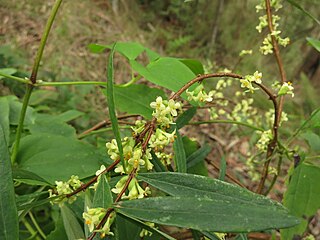
Homoranthus is a genus of about thirty species of plants in the myrtle family Myrtaceae and all are endemic to Australia. Plants in this genus share similarities with those in both Darwinia and Verticordia. They are shrubs with their leaves arranged in opposite pairs and with flowers appearing either singly or in small groups, usually in upper leaf axils. They are found in Queensland, New South Wales and South Australia. The genus was first described in 1836. None of the species is common nor are they well-known in horticulture.

Banksia ornata, commonly known as desert banksia, is a species of shrub that is endemic to south-eastern continental Australia. The Ngarrindjeri people of the Lower Murray region in South Australia know it as yelakut. It has thin bark, serrated, narrow egg-shaped leaves with the lower end towards the base, cream-coloured flowers in a cylindrical spike, and later, up to fifty follicles in each spike, surrounded by the remains of the flowers.

Acacia retinodes is an evergreen shrub that is native to South Australia, Victoria and Tasmania. Short racemes of yellow flowers are produced periodically throughout the year. Some common names are Retinodes water wattle, swamp wattle, wirilda, ever-blooming wattle and silver wattle.

Acacia glaucoptera, commonly known as flat wattle or clay wattle, is a species of Acacia which is endemic to the south-west of Western Australia.

Acacia aciphylla is a shrub belonging to the genus Acacia and the subgenus Juliflorae. It is native to the Mid West region of Western Australia.

Acacia crispula is a shrub belonging to the genus Acacia and the subgenus Phyllodineae that is native to southern parts of Western Australia.
Acacia erioclada is a shrub belonging to the genus Acacia and the subgenus Phyllodineae native to Western Australia.

Acacia gonophylla, also known as rasp-stemmed wattle, is a shrub belonging to the genus Acacia and the subgenus Phyllodineae that is endemic to south western parts of Australia.

Acacia iteaphylla, commonly known as Flinders Range wattle, Port Lincoln wattle, winter wattle and willow-leaved wattle, is a shrub belonging to the genus Acacia and the subgenus Phyllodineae that is endemic to South Australia.

Acacia leptopetala is a shrub belonging to the genus Acacia and the subgenus Phyllodineae that is endemic to an area of south western Australia.

Acacia leptospermoides is a shrub belonging to the genus Acacia and the subgenus Phyllodineae and is endemic to a large area of south western Australia.

Acacia dura is a shrub of the genus Acacia and the subgenus Plurinerves that is endemic to south western Australia.

Acacia loxophylla is a shrub of the genus Acacia and the subgenus Plurinerves that is endemic to an area of south western Australia.

Acacia setulifera is a shrub of the genus Acacia and the subgenus Plurinerves that is endemic to an area of northern Australia.

Leptospermum glaucescens, commonly known as the blue-green tea tree or smoky tea tree, is a species of shrub or small tree that is endemic to Tasmania. It has elliptical to egg-shaped leaves that are often greyish green, white flowers about 15 mm (0.59 in) in diameter arranged in consecutive leaf axils and fruit that remain on the plant for some time after maturity.

Hakea rostrata, common name beaked hakea, is a flowering plant in the family Proteaceae, native to South Australia and Victoria.

Acacia dictyocarpa is a shrub belonging to the genus Acacia and the subgenus Phyllodineae that is endemic to south eastern Australia.

Acacia nematophylla, commonly known as coast wallowa, is a shrub belonging to the genus Acacia and the subgenus Phyllodineae where it is endemic to southern Australia.

Pimelea axiflora, commonly known as bootlace bush, is a small shrub in the family Thymelaeaceae and is endemic to Australia. It is a small shrub with whitish flowers on mostly smooth stems.

Acacia rhigiophylla, commonly known as dagger-leaf wattle, is a shrub belonging to the genus Acacia and the subgenus Juliflorae that is native to southern Australia.




















